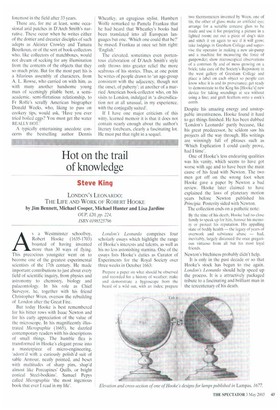Hot on the trail of knowledge
Steve King
LONDON'S LEONARDO: THE LIFE AND WORK OF ROBERT HOOKE by Jim Bennett, Michael Cooper, Michael Hunter and Lisa Jardine OUP, £20, pp. 224, ISBN 0198525796 As a Westminster schoolboy, Robert Hooke (1635-1703) boasted of having invented more than 30 ways of flying. This precocious youngster went on to become one of the greatest experimental scientists of the 17th century. He made important contributions to just about every field of scientific inquiry, from physics and astronomy to chemistry, biology and palaeontology. In his role as Chief Surveyor, he, together with his friend Christopher Wren, oversaw the rebuilding of London after the Great Fire.
But today Hooke is best remembered for his bitter rows with Isaac Newton and for his early appreciation of the value of the microscope. In his magnificently illustrated Micrographia (1665), he dazzled contemporary readers with his descriptions of small things. The humble flea is transformed in Hooke's elegant prose into a masterpiece of micro-engineering, `adorn'd with a curiously polish'd suit of sable Armour, neatly pointed, and beset with multitudes of sharp pins, shap'd almost like Porcupines' Quills, or bright conical Steel-bodkins', Samuel Pepys called Micrographia 'the most ingenious book that ever I read in my life'. London's Leonardo comprises four scholarly essays which highlight the range of Hooke's interests and talents, as well as his no less astonishing stamina. One of the essays lists Hooke's duties as Curator of Experiments for the Royal Society over three weeks in October 1663:
Prepare a paper on what should be observed and recorded for a history of weather; make and demonstrate a hygroscope from the beard of a wild oat, with an index; prepare two thermometers invented by Wren, one of tin, the other of glass; make an artificial eye; arrange for a suitable concave glass to be made and use it for projecting a picture in a lighted room; cut out a piece of dog's skin and stitch it on again to see if it will grow; take lodgings in Gresham College and supervise the operator in making a new air-pump and a machine for measuring the force of gunpowder; show microscopical observations of a common fly and of moss growing on a brick; take care of the Society's Repository in the west gallery of Gresham College and place a label on each object so people can know what it is and its provenance; get ready to demonstrate to the King his [Hooke's] new device for taking soundings at sea without using a line; and graft feathers onto a cock's comb.
Despite his amazing energy and unstoppable inventiveness, Hooke found it hard to get things finished. He has been dubbed 'London's Leonardo' partly because, like his great predecessor, he seldom saw his projects all the way through. His writings are winningly full of phrases such as 'Which Explication I could easily prove, had I time'.
One of Hooke's less endearing qualities was his vanity, which seems to have got worse with age and to have been the main cause of his feud with Newton, The two men got off on the wrong foot when Hooke gave a paper by Newton a bad review. Hooke later claimed to have explained the laws of planetary motion years before Newton published his Principia. Posterity sided with Newton.
The collection ends on a pathetic note: By the time of his death, Hooke had no close family to speak up for him, honour his memory or protect his reputation. His appalling state of bodily health — the legacy of years of overwork and substance abuse — had, inevitably, largely distanced the once gregarious virtuoso from all hut his most loyal friends.
Newton's bitchiness probably didn't help.
It is only in the past decade or so that Hooke's stock has begun to rise again. London's Leonardo should help speed up the process. It is a attractively packaged tribute to a fascinating and brilliant man in the tercentenary of his death.










































































 Previous page
Previous page